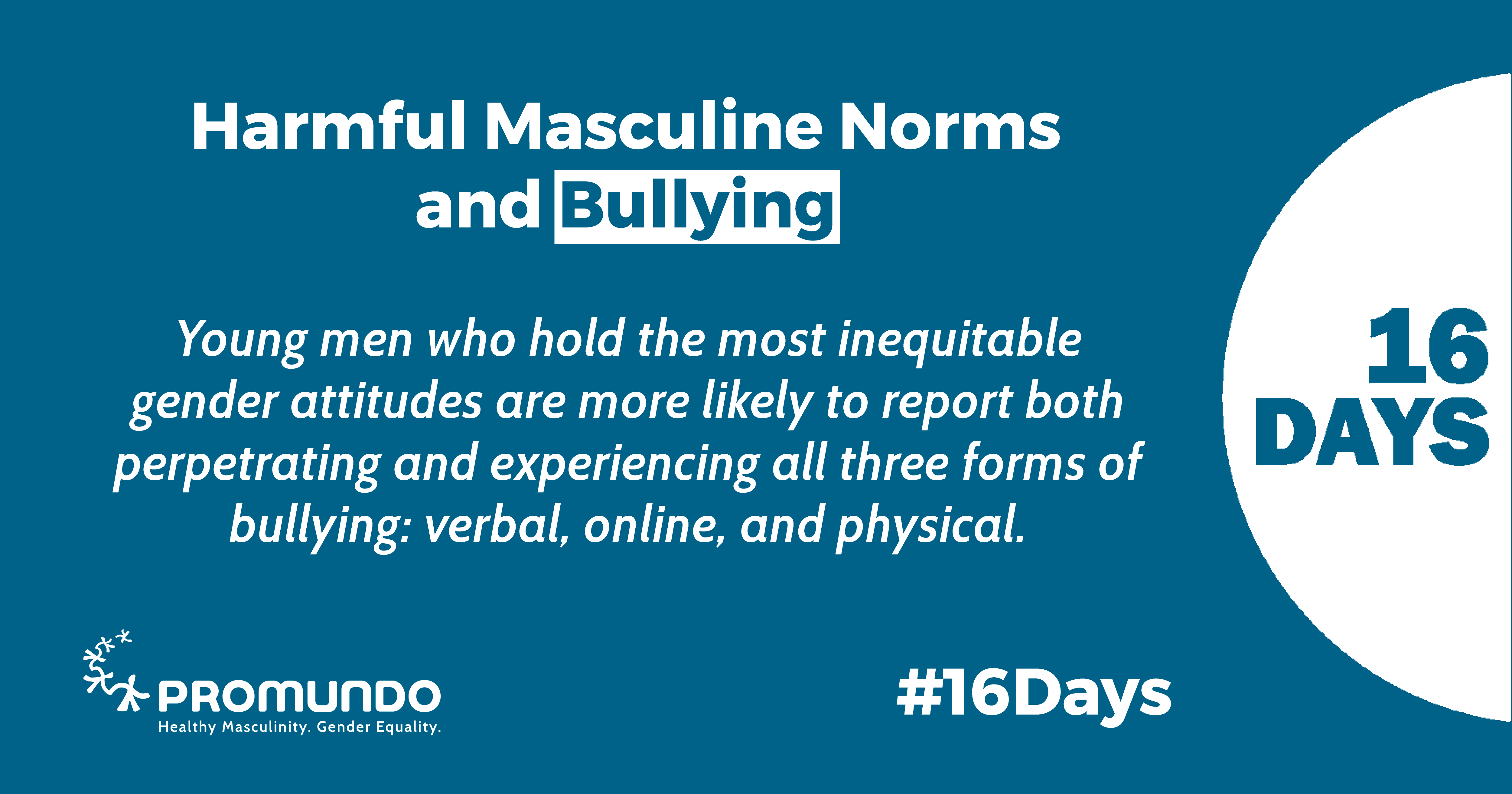Os 16 Dias de Ativismo Contra a Violência de Gênero são uma campanha internacional usada por ativistas ao redor do mundo (25 de novembro a 10 de dezembro) como uma estratégia de organização para pedir a eliminação de todas as formas de violência de gênero.
Este ano, compartilharemos pesquisas sobre as ligações entre normas masculinas prejudiciais e oito formas diferentes de comportamento violento, bem como insights e recomendações para eliminar todas as formas de violência.

Embora não haja nada inerente ao fato de ser homem que impulsione a violência, a maneira como socializamos os meninos em suas identidades como homens e o que esperamos deles — isto é, as normas masculinas da sociedade — estão inegavelmente ligados à violência.
De fato, meninos e homens são frequentemente criados, socializados e incentivados a usar a violência de alguma forma; em geral, homens e meninos têm uma probabilidade desproporcional de perpetrar a maioria das formas de violência e de morrer por homicídio e suicídio. No entanto, a pesquisa afirma que essa violência é prevenível, a igualdade de gênero é alcançável e normas e ideias não violentas sobre masculinidade são predominantes e poderosas.
Relatório da Equimundo e da Oak Foundation Normas Masculinas e Violência: Fazendo as Conexões, examina as ligações entre normas masculinas nocivas e oito formas de comportamento violento. Este quarto blog da série Fazendo as conexões, 16 Dias de Ativismo A série se concentra no bullying. Ela analisa os fatos sobre o assunto, explora suas ligações com outras formas de violência e fornece recomendações para ações.
Assédio moral
Os fatos
O bullying praticado por homens e meninos assume diversas formas. Em um estudo de 2017, A Caixa do Homem, mais de um terço dos jovens nos Estados Unidos, Reino Unido e México relataram ter perpetrado bullying verbal, físico e/ou online no mês anterior à coleta de dados.
Ser vítima de bullying é uma experiência comum para os jovens, e alguns deles sabem que a identificação como LGBTQIA+ foi um dos motivos para o bullying. Jovens que não se enquadram nas normas sociais relacionadas a gênero e sexualidade correm maior risco de sofrer bullying.
As crianças costumam vivenciar o bullying de maneiras diferentes. Os meninos têm maior probabilidade de serem reconhecidos pelos outros como vítimas de bullying. No entanto, os meninos têm maior probabilidade do que as meninas de vivenciar um reconhecimento público prejudicial – em vez de útil ou solidário – dessa vitimização.
Os Links
As masculinidades estão frequentemente na origem da perpetração de bullying por parte dos homens. A Caixa do Homem estudo, homens jovens que tinham as atitudes de gênero mais desiguais (sobre uma variedade de temas, não apenas violência) eram significativamente mais propensos a relatar tanto a perpetração quanto a experiência de todas as três formas de bullying: verbal, online e físico.
Pesquisas sugerem que comportamentos de bullying frequentemente compartilham causas comuns: o desejo do agressor de demonstrar poder e controle sobre a vítima e o uso do bullying para impor conformidade de gênero. Muitos pesquisadores concluem que a identidade de gênero e as normas de gênero violentas contribuem para o bullying, juntamente com muitos outros fatores interligados.
O bullying pode fornecer um caminho para alcançar ou manter status social em ambientes de grupo, como escolas e locais de trabalho.
As Interseções
Qualquer explicação completa do comportamento de bullying deve incluir influências que vão além da masculinidade dominante ou hegemônica. As análises dessas causas identificam uma variedade de níveis de influências interseccionais: o indivíduo, as influências familiares, as influências dos colegas, as influências da escola e as influências comunitárias/culturais (incluindo a pobreza e as influências da mídia).
Crianças expostas a contextos e relacionamentos com conflitos, hostilidade e abusos intensos têm maior probabilidade de praticar bullying, uma descoberta semelhante a outras formas de violência com transmissão intergeracional. Ambientes familiares e educacionais hostis têm sido consistentemente considerados fatores de risco para o bullying.
A localização física, o contexto social e a idade se cruzam e normalizam a prática de bullying por meninos e homens. Por exemplo, em contextos escolares, a agressão física de meninos é frequentemente legitimada como "meninos serão meninos", enquanto o mesmo comportamento de meninas levanta questionamentos, e o mesmo comportamento de um homem de meia-idade em um ambiente de trabalho pode ser considerado inapropriado.
Da Teoria à Prática
Pouquíssimos programas de prevenção ao bullying, especialmente no Sul Global, trabalham para desconstruir masculinidades nocivas. Iniciativas que visam prevenir o bullying devem se concentrar nas seguintes transformações de normas masculinas nocivas:
- Envolva indivíduos de todas as identidades de gênero em discussões sobre como as normas tradicionais de gênero e a não conformidade de gênero estão conectadas à perpetração e às experiências de bullying.
- Explique, ilustre e discuta a conexão direta entre a perpetração de bullying e poder, controle e aceitação social, tendo o cuidado de fazer isso de uma forma que convide à autoconsciência em vez de colocar culpa.
- Ofereça aos participantes um espaço seguro para praticar maneiras não violentas e mais saudáveis de interagir com grupos de colegas e dinâmicas sociais.
- Discuta maneiras pelas quais os participantes podem promover ambientes de grupo e redes de colegas que valorizem expressões saudáveis de masculinidade e acolham, em vez de punir, as diferenças individuais.
